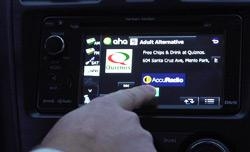 As my wife
and I drive up Route 202 here in Delaware, I am already starting to get a sense of how place-based, geo-fenced media could become a radical departure from media as we have known it for the past
century. Having things in your vicinity ping you will no doubt get bothersome fast -- and some kind of message management will be necessary to filter the flow, of course. But the basic concept of
having physical locations project and broadcast themselves in laser-targeted ways at willing recipients is a remarkable change in media model. Places can talk. Places can broadcast. Places are
media.
As my wife
and I drive up Route 202 here in Delaware, I am already starting to get a sense of how place-based, geo-fenced media could become a radical departure from media as we have known it for the past
century. Having things in your vicinity ping you will no doubt get bothersome fast -- and some kind of message management will be necessary to filter the flow, of course. But the basic concept of
having physical locations project and broadcast themselves in laser-targeted ways at willing recipients is a remarkable change in media model. Places can talk. Places can broadcast. Places are
media.
I am getting a bit of it. With the RetailMeNot app that is triggered by a couple of plazas and malls, my iOS Passport app that alerts me to redeem a saved coupon at the nearby
Walgreens, and geo-fenced to-do lists that ping me as I pass Shop-Rite (get the damned soy milk, finally) when Walgreens is nearby, my highway talks to my phone while in the car. But soon enough, the
car too will be contextually aware.
advertisement
advertisement
In a deal with in-car Web content distribution service Aha by Harman and the location-based mobile ad platform Placecast, Quiznos can now send an ad and
offer to a car dashboard when it enters a designated geo-fence. Inserted in the flow of Aha content, the driver will hear an audio ad for the nearby Quiznos, and the ad will also appear on the
dashboard interface. The driver can give it a quick thumbs-up tap and have the offer for free drink and chips sent to their email address. The user brings their smartphone with the coupon into the
Quiznos and redeems it. the platform also works via Aha on mobile apps for those who plug their cell phones into legacy non-connected dashboards.
Quiznos CMO Susan Lintonsmith tells me that
the technology is allowing them to get a message and an offer down as close to the moment of truth as possible. “Our ultimate goal is to make sure we are reaching the consumer when they are
making a decision in the right time and right place to direct them to the store to redeem the offer.”
On the messaging end the idea was to keep the offer simple but irresistible –
free stuff. “the offer redeems well in print and we felt it would be a compelling test,” she says.
The geo-fence is set about three miles from the locations. Quiznos has already
tested geo-fenced offers on mobile that have performed well. “It is taking center focus right now,” she says as she plans out next year. “Location-based initiatives are on the
forefront and informing the 2014 plan. This test with Aha and Placecast is already occurring nationally for the next several weeks. The Placecast and aha combination allows for targeting not only
against demo and psychographic but even against car make and model and even musical tastes and Web content. The Aha user has to opt in to get geo-fenced offers.
It is interesting that this
also has the benefit of being a multi-touch encounter with the brand. You not only hear that ad, but have to opt in with a tap and then get the offer from email.
Of course, the first skeptical
response to all of this is reviving the Starbucks nightmare scenario of having countless stores pinging you endlessly while out on the road. Drive fast enough through enough high-retail-volume areas
and your phone and dashboard might start lighting up with competing alerts and offers. Okay, sure. Clearly, traffic management would be in order at some point. But the interesting aspect of this is
that places become broadcasters. Not only that, but it is a personalized broadcaster, subject to personal filters and opt-ins. Notice how quickly we move toward a Minority Report scenario. At the very
least, it signifies a new ground for heated competition at the local level for location rights. Consider this: the place becomes the keyword. Just as geo-conquesting is already going on in local
mobile advertising, we could start to see bidding over place.
To be sure, there is a mess of providers and interested parties who want to assert ownership over location as filtered and
personalized by a device. Retail stores, brands, third-party shopping apps, OOH networks, the emerging Bluetooth LTE device in malls and in stores, location-based mobile ad networks, and now your
connected car network – all will be jockeying for position to be the first to meet you virtually as you approach them physically. This could be an interesting augmentation of outdoor life -- or
it could be noisy, cluttered, begging to be turned off.